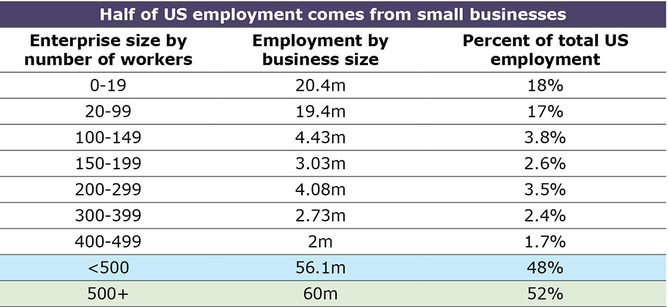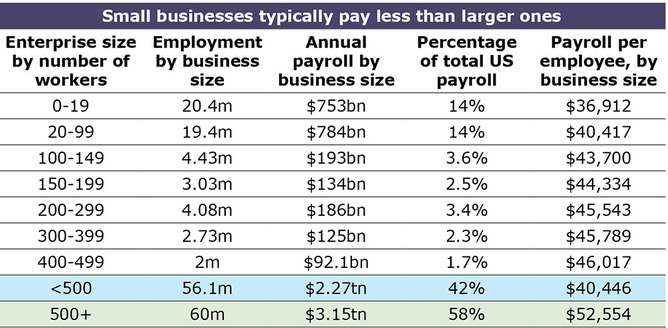Large and Small Businesses Have their Place Driving Economic Growth

Please note that we are not authorised to provide any investment advice. The content on this page is for information purposes only.
Last August, South Main Kitchen, a little restaurant in Alpharetta, Georgia, a small town outside of Atlanta, opened its doors near my wife’s office. Julie, and I, and our friend Mike, were the first ones on the scene and were quick to order a few drinks.
Last August, South Main Kitchen, a little restaurant in Alpharetta, Georgia, a small town outside of Atlanta, opened its doors near my wife’s office. Julie, and I, and our friend Mike, were the first ones on the scene and were quick to order a few drinks.
My diet Coke was the very first drink purchased at the bar. So at the owner’s request, I signed the dollar that bought that Coke, and he taped it to the mirror behind the bar. Since that afternoon, I have gotten to know him and learned that his restaurant employs 30 people – local workers who make a mean batch of sweet-potato fries.
Just a few months later, this January, the Coca-Cola Company announced it was going to eliminate about 1,800 jobs, 500 in the Atlanta market alone. Coke employs approximately 13,000 people at its global headquarters Atlanta, so this would constitute a 3.8% reduction in its workforce here. This is pretty significant.
And as you might expect, Coca Cola’s announcement received plenty of press, while the opening of the small restaurant did not even make it to the local six-o-clock news. Why? Isn’t my dollars’ worth of activity at the bar (buying a diet Coke), just as valuable as a dollar’s worth of activity performed by the Coke company? Well, yes and no.
That bottle of Coke I bought and these two businesses offer a useful snapshot of the US economy, and the challenges Federal Reserve Chair Janet Yellen faces as she and her colleagues try to determine the right time to begin lifting interest rates – which may stall the recovery if done too soon. They’re following the steady drop in the unemployment rate very closely, but given that small businesses like South Main Kitchen are a significant driver of that decline, while larger ones are in some cases still downsizing, it’s unclear that the additional jobs are translating to a stronger economy going forward.
Companies with fewer than 500 employees have added more than 80% of the new private-sector jobs over the past four months, and confidence is near a post-2007 peak for small companies, Bloomberg News reported. So what does that mean for Yellen and the US recovery? Understanding the impact of both South Main Kitchen and Coca-Cola on the broader economy is therefore essential to knowing when it is ready for higher borrowing costs.
(Quick disclaimer, my university gets some funding from Coca-Cola, but I have not received any directly for my research.)
Why big business matters
The workings of large companies receive a lot of attention. And for good reason – very large companies (those with more than 500 employees) employ more than 50% of all workers. The table below shows the number of persons employed in the US by the size of the enterprise.
Number and percentage employed by size of enterprise. US Census Bureau
Coke is a really big company with more than 13,000 employees in Georgia alone. It (and its brethren of companies, such as Turner and Home Depot) hires many people. Companies like the South Main Kitchen (and its brethren) are individually small and collectively are responsible for employing a smaller percentage of workers.
Consider the wages of these smaller companies compared with larger companies. The following table shows the percentage of total payroll associated with firms of different sizes as well as the payroll per employee for those different sized companies. The payroll per employee of a 30-person business averages $38,435, compared with $52,554 for a typical large company.
Employment, payroll and payroll per employee by enterprise size. US Census Bureau
Even if 20 restaurants opened in Atlanta, hiring 30 persons each, the payroll gains from the “small” businesses would not be equal to the payroll gains of the large one. That is to say, there is a reason why people are more concerned or aware of the actions of big companies – those actions are likely to have a larger economic push.
But size is not everything
But places like South Main Kitchen have been instrumental in the economic recovery. This final table identifies the new hires by size of enterprise in Georgia over 12 quarters, running from 2011 through the first three months of 2014. Over that period, when the US recovery began to pick up steam, small businesses claimed most new hires. In other words, more often than not small businesses have been taking the lead in hiring.
The number of new hires in Georgia by enterprise size, 2011 – 2014; more than 20% came from companies with less than 20 employees.US Census Bureau
Remember, that dollar I gave to the restaurant is still stuck to the bar – quite literally. And, although the dollars from its other customers are moving on, the money that flows through a small business might not have the same economic impact as the dollars flowing through bigger firms.
In an economy (a municipality or a county, for example) there are two types of industries: those that support the working of the immediate surroundings, such as a local restaurant, and those that support the workings of a much larger region, like a beverage manufacturer.
The non-basic jobs are those that support the system in its daily function, while the basic industry jobs are those that provide the momentum to the economy. The basic industry jobs are likely to be in large (very large) firms. Jobs in basic industries move economies forward.
Of pourers and producers
My drink at the bar was refreshing, and it had an immediate impact – quenching my thirst. But the drinks produced by the beverage company itself quench a nation (of course, if Coke ever uses “We Quench a Nation” in an ad campaign, I am hiring Marvin Gaye’s family attorney).
So what does all this mean? Smaller businesses are an important driver of economic activity – these enterprises have been the catalyst for more than 50% of new hires historically. But, the punch comes in the form of wages, incomes and economic generation – these are more likely to come from bigger firms. Although we all like to drink at the local pub, there is an economic difference between pouring and producing.
The Fed knows this well, and if they do raise rates in June as some expect, you can be sure it is because they are confident the US’ big producers are back in the game.
Small businesses may drive jobs growth, but their much bigger brethren power the economy is republished with permission from The Conversation







